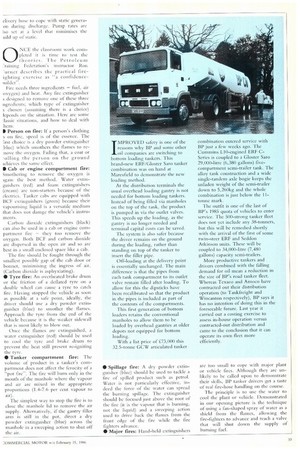I MPROVED safety is one of the reasons why BP and
Page 33

If you've noticed an error in this article please click here to report it so we can fix it.
some other oil companies are switching to bottom loading tankers. This brand-new ERF/Gloster Saro tanker combination was on hand at Marestield to demonstrate the new loading method.
At the distribution terminals the usual overhead loading gantry is not needed for bottom loading tankers. Instead of being filled via manholes on the top of the tank, the product is pumped in via the outlet valves. This speeds up the loading, as the gantry is no longer needed and terminal capital costs can be saved.
The system is also safer because the driver remains on the ground during the loading, rather than standing on top of the tanker to insert the filler pipe.
Off-loading at the delivery point is essentially unchanged. The main difference is that the pipes from each tank compartment to its outlet valve remain tilled after loading. To allow for this the dipsticks have been recalibrated so that the product in the pipes is included as part of the contents of the compartments.
This first generation of bottom loaders retains the conventional manholes to allow them to be loaded by overhead gantries at older depots not equipped for bottom loading.
With a list price of 03,000 this 32.5-tonne GCW articulated tanker combination entered service with BP just a few weeks ago. The Cummins L10-engined ERF CSeries is coupled to a Gloster Saro 29,000-litre (6,380 gallons) fivecompartment semi-trailer tank. The alloy tank construction and a wide single-tandem axle bogie keeps the unladen weight of the semi-trailer down to 5,260kg and the whole combination is just below the 11tonne mark.
The outfit is one of the last of BP's 1985 quota of vehicles to enter service. The 500-strong tanker fleet does not yet include any 38-tonners, but this will be remedied shortly with the arrival of the first of some twin-steer ERF and Seddon
Atkinson units. These will be coupled to 34,000-litre (7,480 gallons) capacity semi-trailers.
More productive tankers and drivers combined with the falling demand for oil mean a reduction in the size of BP's road tanker fleet. Whereas Texaco and Amoco have contracted out their distribution operation (to Tankfreight and Wincanton respectively), BP says it has no intention of doing this in the foreseeable future. Last year it carried out a costing exercise to assess in-house operation versus contracted-out distribution and came to the conclusion that it can operate its own fleet more efficiently.






















































